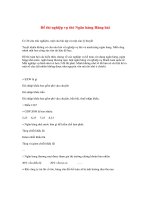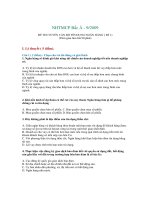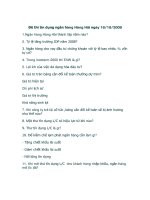Đề thi vào ngân hàng - HSBC
Bạn đang xem bản rút gọn của tài liệu. Xem và tải ngay bản đầy đủ của tài liệu tại đây (308.25 KB, 7 trang )
Thi tuyển vòng loại HSBC tại Kim Đô. Các thí sinh dự thi gồm: Ngoại
Thương, Kinh Tế, Quốc Gia, ...và cả Nhân Văn nữa, có vẻ như yêu cầu
ngoại ngữ là vấn đề chính.
Toàn bộ tests là tiếng anh. Phần đầu check khả năng Anh văn, Phần 2 là
Toán học, Phần 3 là Quan sát. Như kiểu IQ vậy. Thời gian thì bó tay, 94 câu
mà có 32ph. Ko thể nào làm kịp, mắt thì đọc, tay thì bấm máy, ghi chép.
(chọn 600/1500 thí sinh vào vòng trong)
Cảm nghĩ của 1 thí sinh trường ĐH Ngoại Thương:
Có 3 phần thi: Verbal Usage (VP1.2a): 15 phút/40 câu - fill pairs of
words, sử dụng phản xạ từ TA thông thường; Numerical Reasoning
(NP3.1a) chủ yếu là multiple - 10 phút/25 câu; phần cuối là Clerical
checking (CP3.2a) chỉ là check data thôi, nhưng rất đúng chất ngân
hàng . Cái chính vẫn là manage time (mà time là cái tớ chưa bao giờ
manage well cả!) Tệ nhất là phần thi Clerical, vừa bắt đầu thì ý nghĩ
“Ngân hàng ko phải là ngành hợp với mình!” thoảng qua, và thế là…
Đấy, chỉ cần nghĩ như thế thôi là sẽ mất tập trung, ko làm được bài
nữa! 7 phút trôi đi như bay!
CÁC DẠNG CÂU HỎI THI MẪU TẠI HSBC, BẠN CÓ THỂ THAM KHẢO
TẠI 1TRONG 2 WEBSITE:
1.
/>
2.
/>tools/psychometric-test.aspx
(Làm đúng được tầm 70% câu hỏi ở đây là thi tuyển được vào
HSBC rồi )
=====================
Một số câu hỏi mẫu
Verbal reasoning examples
In a verbal reasoning test, you are usually provided with a passage of
information and required to evaluate a set of statements by selecting
one of the following possible answers:
A – True (The statement follows logically from the information or
opinions contained in the passage)
B – False (The statement is logically false from the information or
opinions contained in the passage)
C – Cannot Say (Cannot determine whether the statement is true or
false without further information)
In the example below, give your answer to each question by clicking on
either A, B or C. You will be told whether your answer is correct or not.
“Many organisations find it beneficial to employ students over the
summer. Permanent staff often wish to take their own holidays over this
period. Furthermore, it is not uncommon for companies to experience
peak workloads in the summer and so require extra staff. Summer
employment also attracts students who may return as well qualified
recruits to an organisation when they have completed their education.
Ensuring that the students learn as much as possible about the
organisation encourages interest in working on a permanent basis.
Organisations pay students on a fixed rate without the usual entitlement
to paid holidays or sick leave.”
Statement 1 - It is possible that permanent staff who are on holiday can
have their work carried out by students.
Statement 2 – Students in summer employment are given the same
paid holiday benefit as permanent staff.
Statement 3 – Students are subject to the organisation’s standard
disciplinary and grievance procedures.
Statement 4 – Some companies have more work to do in the summer
when students are available for vacation work.
Numerical reasoning examples
In a numerical reasoning test, you are required to answer questions by
using facts and figures presented in statistical tables. In each question
you are usually given a number of options to choose from. One, and
only one, of the options is correct in each case. If necessary, use a
rough sheet of paper and/or a calculator. However, it is important to
note that the use of a calculator may not be permitted in all tests.
For each question below, click the appropriate button to select your
answer. You will be told whether your answer is correct or not.
Newspaper Readership
Readership (millions) Percentage of adults reading each paper in Year 3
Daily Newspapers
Year 1 Year 2 Males Females
The Daily Chronicle 3.6 2.9 7 6
Daily News 13.8 9.3 24 18
The Tribune 1.1 1.4 4 3
The Herald 8.5 12.7 30 23
Daily Echo 4.8 4.9 10 12
Question 1 - Which newspaper was read by a higher percentage of
females than males in Year 3?
The Tribune The Herald Daily News Daily Echo The Daily Chronicle
Question 2 – What was the combined readership of the Daily Chronicle,
the Daily Echo and The Tribune in Year 1?
10.6 8.4 9.5 12.2 7.8
Amount Spent on Computer Imports
Question 3 – In Year 3, how much more than Italy did Germany spend
on computer imports?
650 million 700 million 750 million 800 million 850 million
Question 4 – If the amount spent on computer imports into the UK in
Year 5 was 20% lower than in Year 4, what was spent in Year 5?
1,080 million 1,120 million 1,160 million 1,220 million 1,300 million
Personality questionnaire examples
Personality questionnaires assess personal behavioural preferences,
that is, how you like to work. They are not concerned with your abilities,
but how you see yourself in the way you relate to others, your approach
to problems and how you deal with feelings and emotions. With this type
of assessment there are no right or wrong answers.
The questions which follow are examples of the type of question you
may come across in personality questionnaires.
There are essentially two formats to personality questionnaires. In one
format, you are asked to rate yourself. In the second, you are asked to
choose between different statements, which look at different aspects of
personality.
Rating Statements
You may be asked to rate yourself on a number of phrases or
statements. After reading each statement you would mark your answer
according to the following rules:
Select circle 1
If you strongly disagree with the statement
Select circle 2
If you disagree with the statement
Select circle 3
If you are unsure
Select circle 4
If you agree with the statement
Select circle 5
If you strongly agree with the statement
In the example below, the first statement has been completed: The
person has agreed that 'I enjoy meeting new people' is an accurate
description of him/herself. Try rating yourself on the other example
questions. Remember there are no right or wrong answers.
1 I enjoy meeting new people
2 I like helping people
3 I sometimes make mistakes
4 I'm easily disappointed
5 I enjoy repairing things
Making Choices









